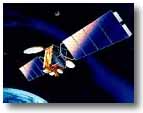ABDO ELGAMA WEB PAGE
VSAT SECTION
A satellite is a specialized wireless receiver/transmitter that is launched by a
rocket and placed in orbit around the earth. There are hundreds of satellites
currently in operation. They are used for such diverse purposes as weather
forecasting, television broadcast, amateur radio communications, Internet
communications, and the Global Positioning System.
-The sattelite is used as a repeater for the incoming signal between the transmitter
and the reciever.

There are three types of communications satellite systems. They are categorized
according to the type of orbit they follow:-
1)A geostationary satellite orbits the earth directly over the equator, approximately 22,000 miles up.
At this altitude, one complete trip around the earth (relative to the sun) takes 24 hours. Thus, the
satellite remains over the same spot on the earth's surface at all times, and stays fixed in the sky from
any point on the surface from which it can be "seen." So-called weather satellites are usually of this
type. You can view images from some of these satellites on the Internet via the Purdue Weather
Processor. A single geostationary satellite can "see" approximately 40 percent of the earth's surface.
Three such satellites, spaced at equal intervals (120 angular degrees apart), can provide coverage of
the entire civilized world. A geostationary satellite can be accessed using a dish antenna aimed at the
spot in the sky where the satellite hovers.
2)A low-earth-orbit (LEO) satellite system employs a large fleet of "birds," each in a circular orbit at
a constant altitude of a few hundred miles. The orbits take the satellites over, or nearly over, the
geographic poles. Each revolution takes approximately 90 minutes to a few hours. The fleet is
arranged in such a way that, from any point on the surface at any time, at least one satellite is on a
line of sight. The entire system operates in a manner similar to the way a cellular telephone network
functions. The main difference is that the transponders, or wireless receiver/transmitters, are moving
rather than fixed, and are in space rather than on the earth. A well-designed LEO system makes it
possible for anyone to access the Internet via wireless from any point on the planet, using an antenna
no more sophisticated than old-fashioned television "rabbit ears."
3)Some satellites revolve around the earth in elliptical orbits. These satellites move rapidly when they
are near perigee, or their lowest altitude; they move slowly when they are near apogee, or their
highest altitude. Such "birds" are used by amateur radio operators, and by some commercial and
government services. They require directional antennas whose orientation must be constantly
adjusted to follow the satellite's path across the sky.
Transponder
A transponder is a signal receiver that automatically responds to a received
signal. Some transponders forward a signal along a designated path at the
same or another frequency. Some transponders automatically return a
programmed message.
In satellite communication, the satellite contains one or more transponders, each of which is tuned to
receive signals at a certain frequency, amplify the signals, and retransmit them on a different
frequency.
Earth Segment|Space Segment|
TDMA System|
BOD System|
What is VSAT|
Retun Home
Important links to me
visit my nice page
MY EDUCATION
ABDO ELGAMAL WEB PAGE

